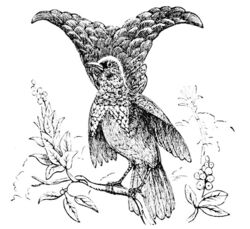Biology:Crescent-caped lophorina
| Crescent-caped lophorina | |
|---|---|

| |
| Scientific classification Error creating thumbnail: Unable to save thumbnail to destination
| |
| Domain: | Eukaryota |
| Kingdom: | Animalia |
| Phylum: | Chordata |
| Class: | Aves |
| Order: | Passeriformes |
| Family: | Paradisaeidae |
| Genus: | Lophorina |
| Species: | L. niedda
|
| Binomial name | |
| Lophorina niedda Mayr, 1930
| |
| Synonyms | |
|
Lophorina superba niedda[1] | |
The crescent-caped lophorina or Vogelkop superb bird-of-paradise (Lophorina niedda), sometimes noted as the curl-caped bird-of-paradise,[2] is a species of the Paradisaeidae (bird-of-paradise) family. It is endemic to the Bird's Head Peninsula in New Guinea (Vogelkop in Dutch).[3] First described in 1930 by Ernst Mayr, it had been treated as a subspecies of the superb bird-of-paradise but was elevated to the status of a full species in 2017,[2] and reinforced in 2018 based on its striking black plumage (its feathers absorb 99.95 percent of light)[4] and behavioral differences, especially visible in the courting male.[3][5]
Etymology
The crescent-caped lophorina's scientific name consists of the words lophorina, meaning "tuft/crest-nose", referring to the upward-standing tufts of feathers behind each nostril, and niedda which refers to the native onomatopoeic name for a bird-of-paradise. The subspecies, L. n. inopinata's specific name means unexpected or unlooked for.
Taxonomy and systematics
Historical sources generally recorded the crescent-caped lophorina as being a subspecies of the superb bird-of-paradise (Lophorina superba niedda); however, in 2017, the crescent-caped lophorina was formally treated as a separate species.[2] There are two known subspecies: L. n. niedda, found on the Wadammen Peninsula; and L. n. inopinata, found on the Doberai Peninsula.[2] There are also several differences in courtship behavior, as well as their geographic isolation from the rest of the population.[3] This classification is disputed, however; the subspecies inopinata comprises the taxon formerly known as L. superba superba, but given a new name,[2] while other taxonomists argue that regardless of the evidence, names should not be reassigned from one recognized taxon to another after over 200 years of consistent application.[6]
Distribution
The crescent-caped lophorina is found in the mountains of Bird's Head Peninsula, in Western New Guinea, Indonesia.[1] It is typically found at heights of 1200–2000 m.[2]
References
- ↑ 1.0 1.1 Cracraft, Joel (1992). "The species of the birds-of-paradise (Paradisaeidae): applying the phylogenetic species concept to a complex pattern of diversification". Cladistics 8: 1–43. doi:10.1111/j.1096-0031.1992.tb00049.x.
- ↑ 2.0 2.1 2.2 2.3 2.4 2.5 Irestedt, Martin; Batalha-Filho, Henrique; Ericson, Per G. P.; Christidis, Les; Schodde, Richard (2017). "Phylogeny, biogeography and taxonomic consequences in a bird-of-paradise species complex, Lophorina–Ptiloris (Aves: Paradisaeidae)". Zoological Journal of the Linnean Society 181 (2): 439–470. doi:10.1093/zoolinnean/zlx004.
- ↑ 3.0 3.1 3.2 Scholes, Edwin; Laman, Timothy G. (2018). "Distinctive courtship phenotype of the Vogelkop Superb Bird-of-Paradise Lophorina niedda Mayr, 1930 confirms new species status". PeerJ 6:e4621: e4621. doi:10.7717/peerj.4621. PMID 29682415.
- ↑ McCoy, Dakota E.; Feo, Teresa; Harvey, Todd Alan; Prum, Richard O. (2018). "Structural absorption by barbule microstructures of super black bird of paradise feathers". Nature Communications 9 (1): 1. doi:10.1038/s41467-017-02088-w. PMID 29317637.
- ↑ "Vogelkop Superb Bird-of-Paradise Confirmed as New Species". Sci-News.com. 18 April 2018. http://www.sci-news.com/biology/vogelkop-superb-bird-of-paradise-05924.html.
- ↑ Elliott A, Collar NJ, Bruce MD, Kirwan GM (2020) The nomenclature of Lophorina (Aves: PARADISAEIDAE), with remarks on the type and type locality of L. superba. Zootaxa 4732 (1): 57‒78.
External links
- "Rare Footage of New Bird of Paradise Species Shows Odd Courtship Dance". Nat Geo Wild Official Channel (YouTube). September 14, 2018. https://www.youtube.com/watch?v=nPhVOZiPokA.
Wikidata ☰ Q55608552 entry
 |

